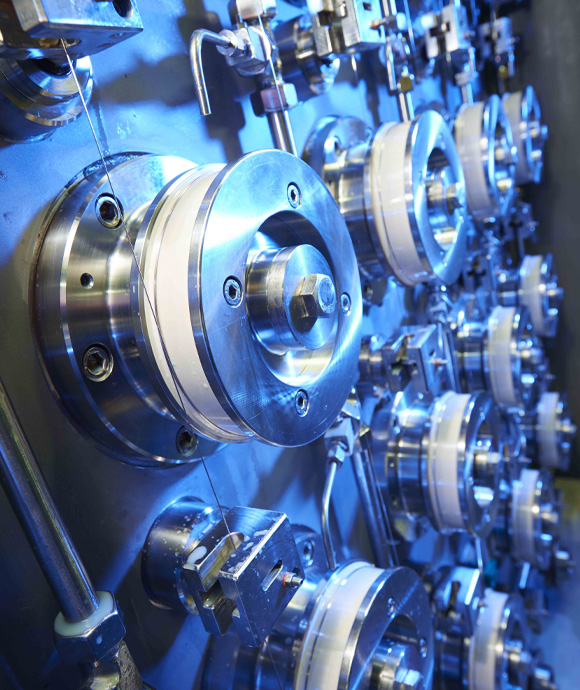Thermocouple wire
JM provides accurate and reliable platinum thermocouple wire for temperature measurement applications. We consistently supply high quality wire and invest in research and development to provide greater value. We offer Type R, Type S and Type B platinum thermocouple wire in many diameters, as well as other special alloys or coatings. Our high purity, specially calibrated platinum wire is ideal for measurement of high temperatures by voltage generated at the junction of two dissimilar metals.
And for particularly harsh environments, we’ve developed HTXTM platinum thermocouple wire - its exceptional strength provides reliable measurements in demanding applications.

Wire types and tolerances
All thermocouple wire is calibrated to special limits or standard grade in our accredited calibration laboratory, in line with international standards.
| Wire type | Working temperature range (0C) |
ASTM E230 / |
BS EN / IEC 60584-1:2013 tolerances | ||||||
| type | -leg | +leg | continuous | intermittent | MIMS form | standard limits | special limits | class 1 | class 2 |
|
S |
Pt |
10%Rh/Pt |
200-1500 |
200-1650 |
200-1300 |
+/-0.25% |
+/-0.1% |
0 to +1100: ±1°C |
0 to +600: ±1.5°C |
|
R |
Pt |
13%Rh/Pt |
200-1500 |
200-1650 |
200-1300 |
+/-0.25% |
+/-0.1% |
|
0 to +600: ±1.5°C |
|
B |
6%Rh/Pt |
30%Rh/Pt |
200-1600 |
200-1750 |
200-1450 |
+/-0.5% |
+/-0.25% |
- |
+600 to +1700: ±0.25% |
|
|
20%Rh/Pt |
40%Rh/Pt |
200-1700 |
200-1850 |
200-1450 |
|
|
8
|
|
|
|
Ir |
40%Ir/Rh |
1000-2100 |
- |
n/a |
|
|
10
|
|
Our Mineral Insulated Metal Sheathed (MIMS) thermocouples provide faster response to temperature change and are resistant to chemical and atmospheric environments. They are available in continuous lengths up to 18 meters.
We also provide fine diameter calibrated wire for Resistance Temperature Detectors (RTDs), allowing fast and accurate measurement of high temperatures. Platinum RTD wire provides long term and stable measurements, the largest temperature range, and a stable resistance against the temperature profile.
Applications
Thermocouple temperature sensors with our precious metal wire provide strong resistance to corrosion, guaranteeing long service life and reliable measurement accuracy.
Platinum and platinum-rhodium thermocouple wires are the ideal technology for measuring high temperatures up to 1850°C, while being able to withstand corrosive environments common in the glass, steel, oil and gas, and semiconductor industries.
Our platinum thermocouple wire is used to measure temperature in:
- Glass manufacturing, including melting furnaces and casting processes.
- Electrically heated furnaces used during melting, casting and hardening processes of various metals.
- Oil and gas industries.
- Diffusion furnaces, crystal growth and epitaxy processes for semiconductor and solar wafer fabrication.
- Calibration, analytical equipment and small furnaces in laboratories.
Wire storage guidance
Following our advice for storing your wire correctly will ensure its optimum performance. This will prevent any problems when using it, such as poor performance and breakages when using or removing the wire from the reel. The following tips will minimise any potential problems:
- Store the reels in the cases supplied in the 'rolling position' to ensure the layers of wire do not tangle.
- Store the wire on the reels it was supplied on, with any supporting bands remaining on the wire until it is used, and replaced if needed.
- Store the wire at a constant temperature and do not subject it to extreme variations, as this will lead to thermal expansion, causing the wire to loosen and slip on the reel. If the wire is stored in a cold environment, we recommend the reels are brought to the working temperature at least 24 hours before use to allow the tension of the wire on the reel to adjust.
- If a reel is part used, take care to ensure the end is correctly and securely tied off. Wire should never be tied up under another wrap of wire as this will cause tangling on future use.
- Reels should not be stacked on each other; this avoids contact between the wire and the flange of another reel.
- Store the reels in a clean environment, preferably in a dry atmosphere to prevent sticking during unwinding.
Full details with example images are available in several languages:
Get in touch



